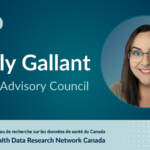Emily Gallant: Advocating for health equity through nursing & health data


Emily Gallant didn’t anticipate that a cancer diagnosis would change her life’s path or ignite a passion for health data advocacy. But, as a registered nurse suddenly placed in the role of patient, Gallant saw firsthand the gaps in health care for marginalized populations, especially those facing rare cancers like her own. Now, she’s working to bridge those gaps as a member of HDRN Canada’s Public Advisory Council (PAC), committed to driving meaningful change in the health data practices.
Gallant’s interest in health care began with a love for medical sciences and a desire to help others. After completing her Bachelor of Science in biochemistry, she pivoted from a traditional medical route to nursing. “I didn’t want the role of a physician,” she explained. “Nursing allows me to provide direct patient care, which is immensely fulfilling.” However, her perspective on health care changed dramatically at 25, when she was diagnosed with a rare form of cancer. “Being a patient exposed me to the systemic inequities in healthcare,” she recalls. Her diagnosis fueled her passion for advocating for better healthcare policies, particularly around the use of health data to improve patient outcomes.
My experience allows me to see where the gaps are and advocate for solutions that enhance health equity. ~ Emily Gallant
Gallant’s role on HDRN Canada’s PAC allows her to combine her professional and personal experiences, ensuring that health data policies account for the realities patients face. “As a patient, I realized that when health data doesn’t reflect diverse demographics, it can lead to treatment gaps,” she explains. In her case, the research on treatment was based on data from older men of a different ethnicity, leaving gaps in how it applied to her treatment.
Her advocacy on HDRN Canada’s PAC focuses on improving health outcomes for marginalized communities, particularly those dealing with rare cancers. “Health data play a critical role in shaping how we treat and care for individuals,” Gallant says. “Involving those with lived experience is essential,” Gallant explains, “because it ensures health care practices stay inclusive and actually reflect the communities they’re meant to serve.”
For Gallant, public involvement in health data decisions is crucial to creating policies that work for everyone. “Those with lived experience bring vital insights into what works and what doesn’t,” she said, emphasizing that public engagement helps to close the gap between health care institutions and the communities they serve. Her work on HDRN Canada’s PAC centres around ensuring that the voices of patients, particularly those from underrepresented groups, are heard in these discussions.
Gallant also advocates for better education around health data, encouraging more public understanding of how data are collected, used, and shared. “There’s a need for more transparency. People need to know how their data impact research and, ultimately, their own care.”
Gallant’s journey from nurse to patient to health advocate has given her a unique perspective on the gaps in health care and the power of data to address them. Through her role on HDRN Canada’s PAC, she’s committed to ensuring that health data practices evolve to serve all Canadians equitably. “My experience allows me to see where the gaps are and advocate for solutions that enhance health equity,” she says. For Gallant, the goal is clear: a health care system that recognizes and responds to the diverse needs of every community, leaving no one behind.
